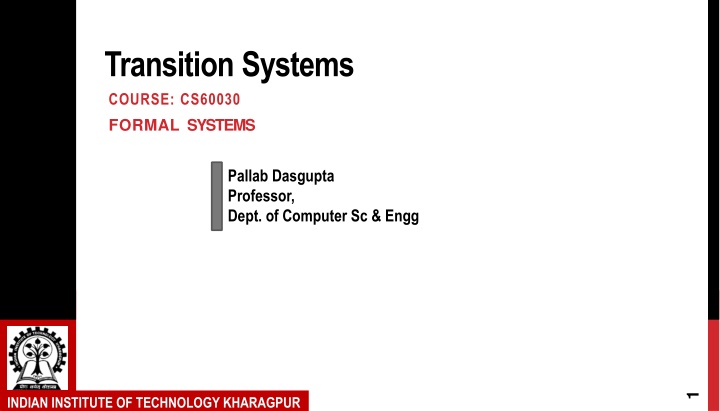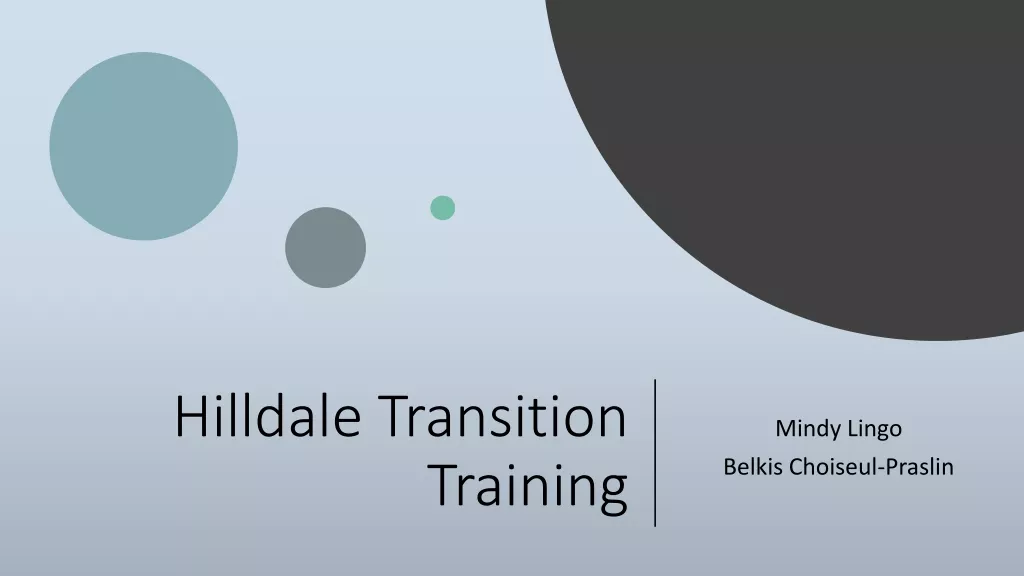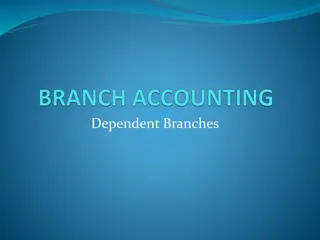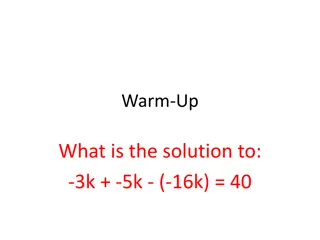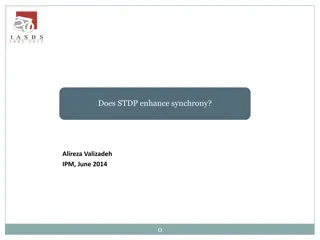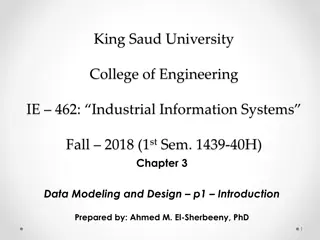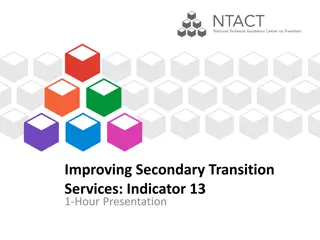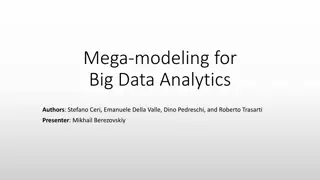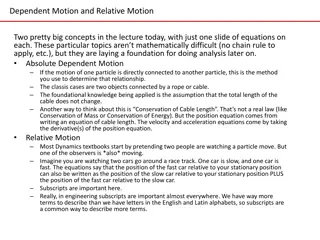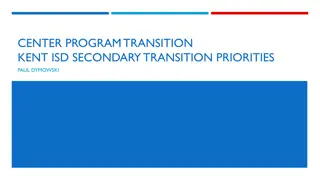Transition Systems and Modeling Data-Dependent Systems
Transition systems play a vital role in modeling the behavior of systems by representing states and transitions. This aids in understanding various system dynamics such as traffic lights, program variables, and more. Explore the concept of transition systems, executions, and data-dependent systems through formal models and theoretical frameworks.
Download Presentation

Please find below an Image/Link to download the presentation.
The content on the website is provided AS IS for your information and personal use only. It may not be sold, licensed, or shared on other websites without obtaining consent from the author.If you encounter any issues during the download, it is possible that the publisher has removed the file from their server.
You are allowed to download the files provided on this website for personal or commercial use, subject to the condition that they are used lawfully. All files are the property of their respective owners.
The content on the website is provided AS IS for your information and personal use only. It may not be sold, licensed, or shared on other websites without obtaining consent from the author.
E N D
Presentation Transcript
Transition Systems COURSE: CS60030 FORMAL SYSTEMS Pallab Dasgupta Professor, Dept. of Computer Sc & Engg 1 INDIAN INSTITUTE OF TECHNOLOGY KHARAGPUR
Overview Lecture #1 Transition systems Executions Modeling data-dependent systems 1
Transition Systems model to describethebehaviour of systems digraphs wherenodesrepresent states, and edges model transitions state: the current colour of a traffic light the current valuesof all programvariables + the programcounter the current value of theregisterstogether with the values of theinput bits transition: ( state change ) a switch from onecolour to another the execution of a programstatement the changeof theregistersand output bits for a newinput 3
Transition System A transition system TS is atuple (S,Act, ,I ,AP,L) where S is a set of states Act is a set of actions S Act S is a transition relation I S is a set of initial states AP is a set of atomic propositions L : S 2AP is a labeling function S and Act areeither finite or countably infinite Notation: s s' instead of (s, , s') 4
A Beverage Vending Machine pay get sprite get_coke insert coin sprite coke select states? actions?, transitions?, initial states? 5
Direct successors and predecessors ?? }, ???? ?,? = ? ? ? ???? ? = ????(?,?) ? ??? ?? }, ??? ?,? = ? ? ? ??? ? = ??? ?,? ? ??? ???? ?,? = ???? ?,? , ???? ? = ???? ? for ? ? ? ? ? ? ??? ?,? = ??? ?,? , ??? ? = ??? ? for ? ? ? ? ? ? State s is called terminal if and only if ???? ? = 6 INDIAN INSTITUTE OF TECHNOLOGY KHARAGPUR
Action and AP-determinism Transition system TS = (S, Act, , I I, AP, L) is action-deterministic iff: | I I | < = 1 and | Post(s, ) | < = 1 for all s,a Transition system TS = (S, Act, , I, AP, L) is AP-deterministic iff: |I | <=1 and | Pos t(s) { s S |L(s') = A } | <= 1 for all s, A 2AP equally labeled successors of s 8
The role of non-determinism Here: nondeterminism is a feature! to model concurrency by interleaving no assumption about the relative speed of processes to model implementation freedom only describes what a system should do, not how to model under-specified systems, or abstractions of real systems use incomplete information In automata theory, nondeterminism may be exponentially more succinct but that s not the issue here! 9
Executions A finite execution fragment Q of TS is an alternating sequence of states and actions ending with a state: ? = ?0?1 ???? such that ?? ??+1??+1for all 0 ? ? An infinite execution fragment of TS is an infinite, alternating sequence of states and actions: ? = ?0?1?2?2 such that ?? ??+1??+1for all 0 ? An execution of TS is an initial, maximal execution fragment a maximal execution fragment is either finite ending in a terminal state, or infinite an execution fragment is initial if s0 I 10
Example Executions sget sget coin select sprite ... coin select sprite pay = pay 1 sprite pay select coke ... select sget cget coin = 2 sget coin coin pay select sprite pay select sprite = Q Execution fragments 1and Qare initial, but 2is not Qis not maximal as it does not end in a terminal state Assuming that 1and 2are infinite, they are maximal 11
Reachable States State s S is called reachablein TS if there exists an initial, finite execution fragment 1 2 n = s . s0 s1 sn ... Reach(TS) denotes the set of all reachable states in TS. 12
Modeling Sequential Circuits {y} {x} y x XOR NOT 0 r 0 1 r 0 x x OR 0 r 1 1 r 1 x x {x r y} r {r} Transition system representation of a simple hardware circuit Input variable x, output variable y, and register r Output function (x r) and register evaluation function x r 13
Atomic Propositions Consider two possible state-labelings: Let AP = { x,y,r } L ((x = 0, r = 1)) = { r } and L ((x = 1, r = 1)) = { x, r, y } L ((x = 0, r = 0)) = { y } and L ((x = 1, r = 0)) = { x } property e.g., once the register is one, it remains one Let AP' '= { x,y} the register evaluations are now invisible L ((x = 0, r = 1)) = and L ((x = 1, r = 1)) = { x, y } L ((x = 0, r = 0)) = { y } and L ((x = 1, r = 0)) = { x } property e.g., the output bit y is set infinitely often 14
Some Preliminaries typed variables with a valuation that assigns values to variables e.g., (x) = 17 and (y) = 2 the set of Boolean conditions over Var propositional logic formulas whose propositions are of the form x D ( 3 < x <= 5) (y = green) (x :( 2 x') effect of the actions is formalized by means of a mapping: Effect : Act Eval(Var) Eval(Var) e.g., x := y+5 and evaluation (x) = 17 and (y) = 2 Effect( , )(x) = (y) + 5 = 3, and Effect( , )(y) = (y) = 2 17
Program Graphs A program graph PG over set Var of typed variables is a tuple (Loc,Act,Effect, ,Loc0,g0) where Loc is a set of locations with initial locations Loc0 Loc Act is a set of actions Effect : Act Eval(Var) Eval(Var) is the effect function Loc ( Cond( Var ) Act ) Loc, transition relation g0 Cond(Var) is the initial condition. g: Notation: l l'denotes (l,g, , l') 18
Beverage Vending Machine Loc = { start, select } with Loc0 = { start } Act = { cget, sget, coin, ret_coin, refill } Var = { nsprite, ncoke } with domain { 0, 1, , max } Effect( coin, ) = Effect( ret_coin, ) = Effect( sget, ) = [ nsprite := nsprite 1 ] Effect( cget, ) = [ ncoke := ncoke 1 ] Effect( refill, ) = [ nsprite := max, ncoke := max ] g0 = ( nsprite = max ncoke = max ) 19
From program graphs to transition systems Basic strategy: unfolding state = location (current control) l + data valuation initial state = initial location satisfying the initial condition g0 Propositions and labeling propositions: at l and x D for D dom(x) (l , ) is labeled with at l and all conditions that hold in g: l l'and g holds in then (l, ) (l ,Effect( , )) 20
Structured operational semantics premise conclusion The notation means: If the proposition above the solid line (i.e., the premise) holds, then the proposition under the fraction bar (i.e., the conclusion) holds Such if ..., then ... propositions are also called inference rules If the premise is a tautology , it may be omitted (as well as the solid line ) In the latter case, the rule is also called an axiom 21
Transition Systems for Program Graphs The transition system TS(PG) of program graph PG = (Loc,Act,Effect, ,Loc0,g0) over set Var of variables is the tuple (S,Act, ,I I,AP,L) where S = Loc Eval(Var) ?:?? ? ? ?(? , Effect ?,? ) ? S Act S is defined by the rule: (?,?) I I = {(l, ) |l Loc0, | = g0 } AP = Loc Cond (Var) and L((l, )) = {l} {g Cond (Var) | | = g}. 22
Transition systems versus Finite Automata As opposed to finite automata, in a transition system: there are no accept states set of states and actions may be countably infinite may have infinite branching actions may be subject to synchronization nondeterminism has a different role Transition systems are appropriate for reactive system behaviour 24
